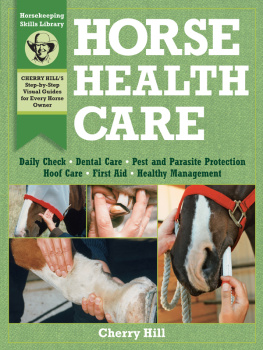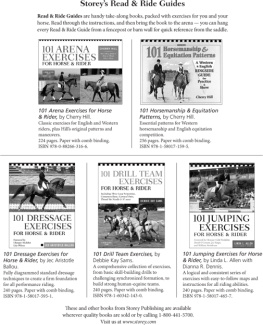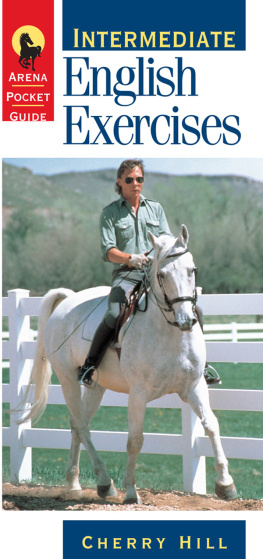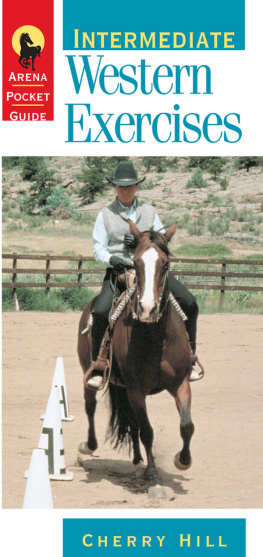101 Horsemanship & Equitation Patterns
A Western & English RINGSIDE GUIDE for Practice & Show
Cherry Hill
Illustrations by Richard Klimesh

Also by Cherry Hill
Longeing and Long Lining the English and Western Horse
101 Longeing and Long Lining Exercises, English and Western
Beginning English Exercises
Intermediate English Exercises
Advanced English Exercises
Beginning Western Exercises
Intermediate Western Exercises
Advanced Western Exercises
Horse Health Care
Horse Handling and Grooming
Your Pony, Your Horse
Horse for Sale
101 Arena Exercises
Horseowners Guide to Lameness (with Dr. Ted S. Stashak)
Maximum Hoof Power (with Richard Klimesh)
Making Not Breaking
Becoming an Effective Rider
Horsekeeping on a Small Acreage
From the Center of the Ring
The Formative Years
The mission of Storey Publishing is to serve our customers by publishing practical information that encourages personal independence in harmony with the environment.
Edited by Marie Salter
Cover design by Betty Kodela
Cover photographs by Richard Klimesh
Text design and production by Susan Bernier
Indexed by Susan Olason/Indexes & Knowledge Maps
1999 by Cherry Hill
All rights reserved. No part of this book may be reproduced without written permission from the publisher, except by a reviewer who may quote brief passages or reproduce illustrations in a review with appropriate credits; nor may any part of this book be reproduced, stored in a retrieval system, or transmitted in any form or by any means electronic, mechanical, photocopying, recording, or other without written permission from the publisher.
The information in this book is true and complete to the best of our knowledge. All recommendations are made without guarantee on the part of the author or Storey Publishing. The author and publisher disclaim any liability in connection with the use of this information. For additional information please contact Storey Publishing, 210 MASS MoCA Way, North Adams, MA 01247.
Storey books are available for special premium and promotional uses and for customized editions. For further information, please call 1-800-793-9396.
Printed in the United States by Versa Press
10 9 8 7 6 5
Library of Congress Cataloging-in-Publication Data
Hill, Cherry, 1947
101 horsemanship and equitation patterns : a western & english ringside guide for practice & show / Cherry Hill.
p. cm.
Includes index.
ISBN 978-1-58017-159-5
1. Show riding. 2. Horse show patterns. 3. Horse shows English performance classes.
4. Horse shows Western division and classes. I. Title. II. Title: One hundred one horsemanship and equitation patterns.
SF295.2.H55 1999
798.24dc21
98-55399
CIP
Contents
Acknowledgments
Thanks to Doug, Laurie, Rachel, and Tyler Krause, for being photo models.
On the cover, Laurie Krause is riding Fabulously Fancy, owned by Linda Collins. Rachel Krause is riding her own Bitasweet Conclusion.
Foreword
Thank you, Cherry Hill, for the knowledge you share as horseman, coach, judge, and instructor. This collection of patterns, explanations, and tips provides valuable information and instruction for all riders. The guidelines are organized and easy to follow. Because the steps are carefully planned and visual aids are used, riders will have a better feel for their pattern work, which can only translate to improved organization and control in the ring.
Judges will also find the patterns in this book useful they will undoubtedly inspire countless variations and new patterns.
A good horseman is a good horseman, whether performing Reining, Western Riding, Horsemanship, Equitation, or Dressage. All riders will benefit from this book, not only by developing better skills but by improving pattern work. Progressive levels of difficulty are offered to suit particular riders needs.
To those who seek to be better riders, enjoy!
Carla Wennberg
Carla Wennberg is an American Quarter Horse Association World Championship rider and international AQHA and National Reining Horse Association judge. She was a college equine science program instructor for ten years and has trained and coached amateur and youth riders in state and national competitions. Carla is the Director of Reining for the United States Equestrian Team.
Introduction
Equitation is the art of riding. It requires correct overall rider position and effective use of the aids: the mind, the hands, legs, seat, and upper body. Equitation is generally the term associated with English riding, Hunt Seat, Saddle Seat, and Dressage. Horsemanship is the term generally used for Western Equitation, but it is also called Stock Seat Equitation.
In Equitation and Horsemanship classes, the performance of the rider is judged, not the conformation or training of the horse. However, an attractive, well-trained horse certainly helps to showcase a riders skills.
Horsemanship and Equitation patterns are excellent practice for anyone who wants to test and improve their own riding skills. They are also very useful during lessons for both the instructor and the student to identify areas that require more work.
In a horse show, Horsemanship and Equitation patterns are used in conjunction with group rail work to evaluate youth and amateur Equitation riders. Each association has its own set of rules for Horsemanship and Equitation outlined in a rule book that is updated each year. (See Appendix for a list of associations.)
THE RIDERS POSITION AND PERFORMANCE
Equitation and Horsemanship classes are designed to measure the ability of the rider to perform a set of maneuvers prescribed by the horse show judge. The judge looks for precision, smoothness, and balance. The rider should maintain a functional and correct body position yet remain relaxed and natural. The pattern should be performed with precision and a subtle use of aids and cues.
Regardless of height, weight, or shape, a rider should never try to force his or her body into an unnatural position. Each style of riding has its own ideal position, but in any class the rider should look natural. If, in the attempt to attain perfect posture, and despite lessons and exercises, you find that your ankle or knee turns out more than the ideal, learn to live with it and instead concentrate on the effective use of your natural aids.
THE NATURAL AIDS
The natural aids are the mind, the upper body, the base (seat, weight, and thighs), the lower legs, and the hands.
Your mind is your most important aid in Equitation and Horsemanship and, in fact, in any riding. It allows you to control an animal many times your size. Your mind provides you with the means to memorize a pattern, to visualize it before you ride, and to stay keen yet relaxed.
Your upper body assists you in maintaining equilibrium during the various direction, gait, and speed changes required. A mere tilt of the head can affect the overall balance of a horse-and-rider team.
The action of the hands on the reins is often overemphasized by novice riders but becomes subtler with advanced riders. Through the bridle, you have the power to influence the shape of a movement, the gait, the rhythm of a gait, the rate and length of stride, and the weight distribution between front and rear, and to slow down or stop movement altogether. You will hold your hands according to the head position of your horse and your style of riding.






